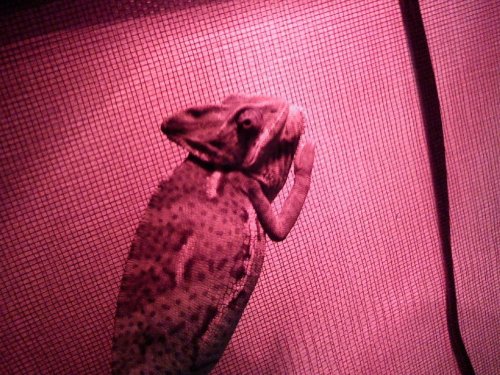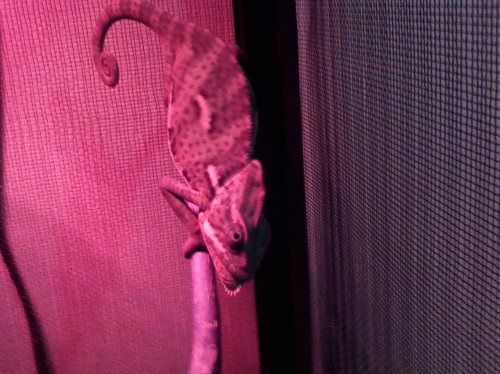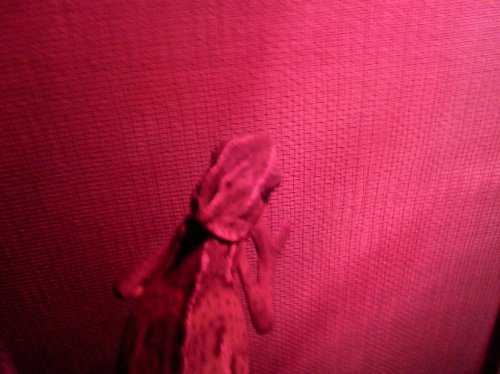I've feed my chameleon 15 crickets a day with calcium powder and the crickets have carrot , potato, or celery and calcium gut load drivk in the cage but my chameleons veil looks messed up and I read some where it could be MBD what do you think it is and if it is MBD what should I do I'll try posting some pics
Navigation
Install the app
How to install the app on iOS
Follow along with the video below to see how to install our site as a web app on your home screen.
Note: This feature may not be available in some browsers.
More options
You are using an out of date browser. It may not display this or other websites correctly.
You should upgrade or use an alternative browser.
You should upgrade or use an alternative browser.
Why does my chameleons veil look this way?
- Thread starter Drbarber
- Start date
vegas shooby
New Member
For real u need to take that light out..don't look right
FFSTRescue
New Member
Lighting
For the sake and health of your chameleon, click on the following link and read about lighting needs for your chameleon. I also copied and pasted the lighting section of the caresheet below.
http://reptileuv.com/reptile-caresheets/veiled-chameleon.php
"Chameleons require a source of UV lighting that emits both UVA and UVB rays. This can easily be accomplished one of two ways. You could either use a Mercury Vapor Bulb that satisfies the requirement for a basking bulb and an active UV source all in one, or you could use a fluorescent tube fixture. Currently, new technology has become available. There is now a superior light that "outshines" the rest. For more information, visit: Reptile UV
Mercury Vapors are a bit more expensive in the short term, but have a maximum life of 1 year. That is almost double the output of a fluorescent tube light. They can also project UV lighting 3 times as far, reaching a 3 foot radius depending on which brand and wattage you use.
When using a Mercury Vapor Bulb, be sure to thoroughly test the temperatures, you may have to put it further above the cage to achieve a safe temperature. These lighting units should be placed in a porcelain socket. They get extremely hot and have the potential to melt conventional lighting sockets.
If you opt to use a fluorescent tube style light, you will need to purchase a fixture for it. You will want to use a good quality light fixture that has ample wattage for the bulb you choose.
For a veiled chameleon, you will want to choose something like an Iguana-light 7.0, Desert-light 8.0, Repti-Sun 5.0, or an Exo-Terra 5.0. Generally, you should use a fixture as long as your enclosure is wide, and place it on top of the cage so that your chameleon can bask in the rays.
These bulbs are generally less expensive, but require a housing fixture. You must also replace the bulb at least every 6 months. After 6 months, the level of UV rays that it projects have seriously declined, and it may not be producing enough UV for your chameleon to produce D3.
Reptiles produce Vitamin D3 when exposed to UVB rays. Wild Chameleons manufacture their own vitamin D3 by basking in unfiltered sunlight. The ultraviolet radiation from the sun acts like a catalyst, which converts a substance known as pro-vitamin D3 into pre-vitamin D3. In turn, this pre-vitamin D3 is converted into vitamin D3, which binds to a blood protein and then can be transferred to the liver via the bloodstream. This "activated" form of D3, then can be utilized to influence the metabolism of dietary calcium and phosphorus.
Vitamin D3 aids in Calcium absorption. This will help to prevent Metabolic Bone Disease as well as other ailments.
When at all possible, expose your chameleon to unfiltered sunlight. Exposing your Chameleon to sunlight through glass or plexi-glass is useless. These items filter out the required UV rays.
About 4-5 hours of natural sunlight is equivalent to a week or more under artificial lighting. (Artificial lighting should be made available daily when the Chameleon is indoors.)
Be certain that the outside temperatures are not too low. A temperature range of 68 or above is adequate.
Your chameleon must also be provided with a shady location to remove itself from the suns rays if it becomes too hot and the frequency of misting should be increased for Chameleons that are basking outside.
An easy way to accomplish all of this is to setup an outdoor enclosure, which will also keep your Chameleon safe while outside"
What they don't mention is that if you are going to use the tube-style lighting, the fluorescent fixtures they mention above, with Zoo-Med Reptisun 5.0 being the best, you will also need a separate, "regular" light bulb for the chameleon to "bask" and absorb heat
For the sake and health of your chameleon, click on the following link and read about lighting needs for your chameleon. I also copied and pasted the lighting section of the caresheet below.
http://reptileuv.com/reptile-caresheets/veiled-chameleon.php
"Chameleons require a source of UV lighting that emits both UVA and UVB rays. This can easily be accomplished one of two ways. You could either use a Mercury Vapor Bulb that satisfies the requirement for a basking bulb and an active UV source all in one, or you could use a fluorescent tube fixture. Currently, new technology has become available. There is now a superior light that "outshines" the rest. For more information, visit: Reptile UV
Mercury Vapors are a bit more expensive in the short term, but have a maximum life of 1 year. That is almost double the output of a fluorescent tube light. They can also project UV lighting 3 times as far, reaching a 3 foot radius depending on which brand and wattage you use.
When using a Mercury Vapor Bulb, be sure to thoroughly test the temperatures, you may have to put it further above the cage to achieve a safe temperature. These lighting units should be placed in a porcelain socket. They get extremely hot and have the potential to melt conventional lighting sockets.
If you opt to use a fluorescent tube style light, you will need to purchase a fixture for it. You will want to use a good quality light fixture that has ample wattage for the bulb you choose.
For a veiled chameleon, you will want to choose something like an Iguana-light 7.0, Desert-light 8.0, Repti-Sun 5.0, or an Exo-Terra 5.0. Generally, you should use a fixture as long as your enclosure is wide, and place it on top of the cage so that your chameleon can bask in the rays.
These bulbs are generally less expensive, but require a housing fixture. You must also replace the bulb at least every 6 months. After 6 months, the level of UV rays that it projects have seriously declined, and it may not be producing enough UV for your chameleon to produce D3.
Reptiles produce Vitamin D3 when exposed to UVB rays. Wild Chameleons manufacture their own vitamin D3 by basking in unfiltered sunlight. The ultraviolet radiation from the sun acts like a catalyst, which converts a substance known as pro-vitamin D3 into pre-vitamin D3. In turn, this pre-vitamin D3 is converted into vitamin D3, which binds to a blood protein and then can be transferred to the liver via the bloodstream. This "activated" form of D3, then can be utilized to influence the metabolism of dietary calcium and phosphorus.
Vitamin D3 aids in Calcium absorption. This will help to prevent Metabolic Bone Disease as well as other ailments.
When at all possible, expose your chameleon to unfiltered sunlight. Exposing your Chameleon to sunlight through glass or plexi-glass is useless. These items filter out the required UV rays.
About 4-5 hours of natural sunlight is equivalent to a week or more under artificial lighting. (Artificial lighting should be made available daily when the Chameleon is indoors.)
Be certain that the outside temperatures are not too low. A temperature range of 68 or above is adequate.
Your chameleon must also be provided with a shady location to remove itself from the suns rays if it becomes too hot and the frequency of misting should be increased for Chameleons that are basking outside.
An easy way to accomplish all of this is to setup an outdoor enclosure, which will also keep your Chameleon safe while outside"
What they don't mention is that if you are going to use the tube-style lighting, the fluorescent fixtures they mention above, with Zoo-Med Reptisun 5.0 being the best, you will also need a separate, "regular" light bulb for the chameleon to "bask" and absorb heat
Last edited:
Julirs
New Member
Is the light you have on him a red light? Do you have light on him at night?
You really need a ZooMed Reptisun 5.o linear tube-this is UVB that chameleons need to stay healthy. You also need a separate basking light, and this can be a regular household light bulb from 40-75 watts or whatever it takes to get a basking spot to the right temp. You need no light or heat at night unless temps are dropping well below 60 degrees.
You really need a ZooMed Reptisun 5.o linear tube-this is UVB that chameleons need to stay healthy. You also need a separate basking light, and this can be a regular household light bulb from 40-75 watts or whatever it takes to get a basking spot to the right temp. You need no light or heat at night unless temps are dropping well below 60 degrees.
Similar threads
- Replies
- 1
- Views
- 1K
- Replies
- 4
- Views
- 344



